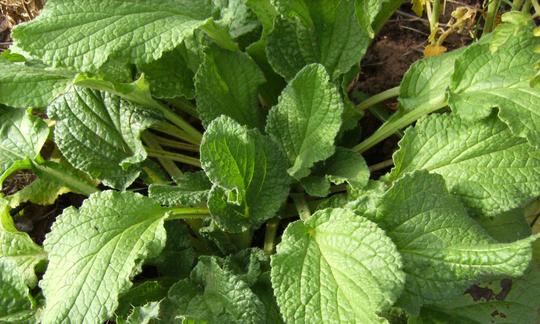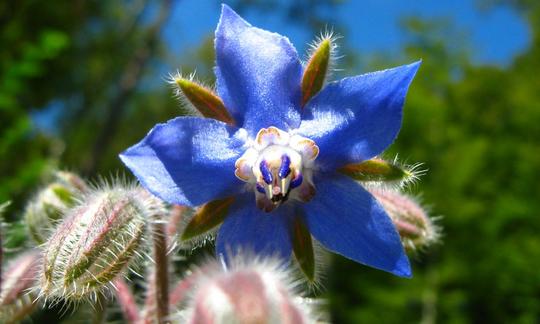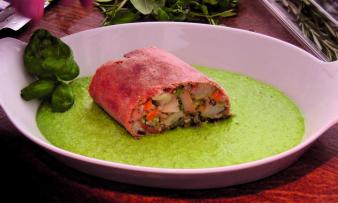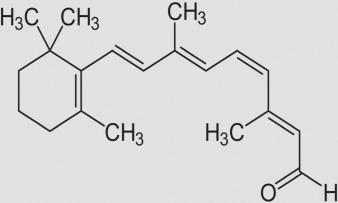Table of contents
Since fresh borage ( Borago officinalis) contains high levels of liver-toxic pyrrolizidine alkaloids (PA), the Federal Institute for Risk Assessment ( BfR) advises against eating the flowers and leaves of the so-called cucumber herb. Borage seed oil, on the other hand, is free of PA and is mainly used as a food supplement.
Use in the kitchen:
Are the leaves of borage really poisonous? Borage, comfrey, viper's bugloss, coltsfoot, butterbur, lungwort and stone seeds have three things in common: they are traditional medicinal plants and former food plants, but they also contain liver-toxic alkaloids. Occasional consumption of small amounts was once considered harmless. Today, the Federal Institute for Risk Assessment ( BfR) recommends avoiding the consumption of foods containing pyrrolizidine alkaloids (PA).
PA-producing plants are no longer consumed, with the exception of borage. The so-called cucumber herb is still a traditional ingredient in the Frankfurt Green Sauce, which is very popular in Hesse (D). Borage is also still used in Liguria (I) to fill ravioli and pansoti. 1,2
Borage was valued for its cucumber-like and refreshingly sour to slightly sweet taste. Leaves and flowers were used as an addition to raw vegetables, salads and soups or to flavor cold drinks. 1,2
Vegan recipe with borage:
Can you eat borage? Due to the contamination of food by PA-producing plants, there is a serious and poorly controlled exposure to the highly toxic pyrrolizidine alkaloids. For your own protection, you should refrain from knowingly eating plants that themselves produce PA - even if they are traditionally considered edible. For this reason, we do not suggest a recipe with borage here.
In recipes with borage, you can replace the former food plant with dill or lemon balm, for example.
Vegan recipes with borage can be found under the note: " Recipes that have the most of this ingredient ".
| Not only vegans or vegetarians should read this: Vegans often eat unhealthily. Avoidable nutritional mistakes. |
Shopping - where to buy?
Seeds and seedlings are available online or in specialist shops, often with the information that borage is a tasty vegetable. Dried or fresh leaves and flowers can be bought online, directly from the farmer and in Hesse (D) at the weekly market or in grocery stores. Depending on the season, it may be possible to buy borage products in supermarkets such as Coop, Migros, Denner, Volg, Spar, Aldi, Lidl, Rewe, Edeka or Hofer as well as in organic supermarket chains such as Denns or Alnatura.
The presence and problem of PA may not always be mentioned. When buying herbal mixtures, pay attention to the ingredients list. Dried or frozen mixtures may contain borage.
The BfR recommends not using any food supplements based on PA-producing plants such as borage, comfrey, viper's bugloss, agrimony, butterbur, lungwort, stone seed or coltsfoot. On the one hand, the health benefits of these preparations are not certain and on the other hand, they are offset by the possible mutagenic and carcinogenic effects of PA. According to the BfR, the situation is different with oil-based extracts, in which no PA has been found to date. 3
In some countries, the use of all parts of the borage plant, except for the oil from the seeds, is strictly regulated. 4 In Germany, there are no restrictions on the use of borage. The interested and informed consumer can, at least by looking at the list of ingredients, identify increased PA levels in borage and react accordingly. In Belgium, borage has been banned from foodstuffs since 1997 due to its PA content. 2
In one study, herbal mixtures containing borage had an ingredient-related PA content of around 200 µg/kg. Daily consumption of around 2 g of such a herbal mixture may be acceptable (for an adult). However, it should be noted that the total exposure can be increased by other foods such as herbal tea or honey. 2
Found in the wild - Season:
The annual (not perennial) borage reaches a height of up to 70 or 80 cm. The upright and hollow stems and the lanceolate leaves, up to 15 cm long, are bristly hairy. From May or June to September the plant forms flowers with five pink petals (flowering season). Later they turn bright blue due to the change in the pH value. The fruits are tiny, brownish-black seeds. 1.4
Storage:
Borage oil should be stored in the refrigerator, protected from light, as otherwise premature oxidation of the highly unsaturated fatty acids will occur. It is advisable to buy small bottles and use them promptly.
Ingredients - nutritional value - calories:
Borage seed oil (Boraginis oleum) contains up to 40% oil with a high proportion of unsaturated fatty acids. Pyrrolizidine alkaloids are present in trace amounts at most. 5 According to the BfR, no PAs were found in food supplements based on borage oil. 3
Borage seed oil consists of 35-38% linoleic acid (omega-6 fatty acid, AL), 17-28% gamma-linolenic acid (corresponds to the highest known proportion in seeds), 16-20% oleic acid, 10-11% palmitic acid, gadoleic acid, 3.5-4.5% stearic acid, 1.5-3.5% erucic acid, about 1.5% nervonic acid and <1% arachidic acid, behenic acid, palmitoleic acid, vaccenic acid, myristic acid, eicosadienoic acid and alpha-linolenic acid (omega-3 fatty acid, ALA). 6
Oil-producing companies confirm that rarely used vegetable oils such as borage oil exceed the maximum erucic acid content recommended by the BfR (20 g/kg). Erucic acid is a monounsaturated omega-9 fatty acid. The current maximum erucic acid content permitted in the production of edible oils is 50 g/kg. 7
So far, seven pyrrolizidine alkaloids have been identified in borage (Boraginis herba), including non-toxic alkaloids and the unsaturated alkaloids amabiline and supinidine, which are classified as liver toxic and carcinogenic. 5 The herb also contains 3% tannins, up to 2.2% soluble silicic acid and around 11% raw mucilage, which after hydrolysis yields glucose, galactose and arabinose. 5 Other ingredients are resin, saponins, potassium nitrate, various fatty acids and essential oils. The vitamin C content of the fresh plant is 149.3 mg per 100 g fresh weight. 6
Borage flowers (Boraginis flos) contain small amounts of bornesite and allantoin, as well as raw mucilage and mineral salts, mainly potassium salts. 5 Also contained are mucilage, tannins, resin, saponins, potassium nitrate, silicic acid, various fatty acids, essential oils, vitamin C and pyrrolizidine alkaloids. 6
Previously, it was assumed that the dried borage plant contained 10 µg/kg of PA. Scientists at the Institute for Pharmaceutical Biology at the Technical University of Braunschweig have now found up to 150 µg of these toxins per kg. This is 15 times the amount originally assumed, which is certainly worrying. 8
The BfR reports on eight borage samples examined with an average value of 50.562 µg/kg and a maximum content of 248.061 µg/kg. The institute classifies the average PA content in borage as particularly high. 9
You can find all the ingredients, the coverage of the daily requirement and comparison values with other ingredients in our nutrient tables. In the article Nutrients explained you will get a detailed insight into the topic.
Health aspects - effects:
Polyunsaturated fatty acids such as gamma-linolenic acid play an important role in skin nutrition. The human body can produce gamma-linolenic acid from the usually abundant linoleic acid (LA, omega-6 fatty acid) using the enzyme delta-6-desaturase. However, this enzyme can be reduced due to metabolic diseases such as diabetes, as a result of aging or genetic factors. Studies have shown that borage oil and evening primrose oil can renew a damaged skin barrier in patients with eczema, normalize water loss through the skin and improve skin smoothness. Even with healthy skin, taking oil rich in gamma-linolenic acid can lead to improvements in skin parameters. 10
Borage oil is used as a dietary supplement, for example, for neurodermatitis (atopic dermatitis) and for lipid metabolism disorders (dyslipidemia), similar to the gamma-linolenic acid-rich evening primrose oil (Oenotherae oleum).
Dangers - Intolerances - Side effects:
Is borage carcinogenic? Pyrrolizidine alkaloids are questionable and undesirable in food due to their liver-damaging effects. The subgroup of unsaturated PA is particularly problematic and has been shown to be mutagenic and carcinogenic in animal experiments. Herbs such as borage, which themselves produce PA (more precisely 1,2-unsaturated PA), lead to high PA exposure. 2,9
The liver is the primary target organ of PA-related damage, but other organs such as the lungs can also be affected. The harmful effects of unsaturated PA occur when large amounts are consumed within a short period of time, and after a longer period of time when lower doses are consumed. Typical consequences, especially when higher doses are consumed, are hepatic vein occlusion and liver damage, which can lead to liver necrosis. 9
Various websites, sales websites and Wikipedia emphasise that occasional consumption of borage is considered harmless. However, the BfR also warns against small intakes, as these can increase the risk of cancer, particularly if consumed regularly. Based on current knowledge, no safe intake level can be defined for genotoxic-carcinogenic substances. The Federal Institute for Risk Assessment therefore recommends minimising these substances as much as is reasonably achievable. 9
There are numerous documented cases of poisoning by PA-containing plants or PA-contaminated foods in the literature. The latter can be, for example, honey, herbal teas, herbs, spices, salad, food supplements and - especially in third world countries - contaminated grain. While severe poisoning is often fatal, a full recovery is possible in milder cases. 9,11,12
A high content of erucic acid in food can have harmful effects on health, as it can lead to fatty degeneration of the heart (myocardial lipidosis). One possible consequence is damage to the heart muscle. The lipidosis caused by erucic acid is reversible. 7
The maximum level for erucic acid in food is regulated in EU Regulation (EC) No. 1881/2006: it is currently 50 g/kg. However, the maximum level is not a health limit and does not indicate whether there is a health risk if the level is exceeded. 7
There is a long-term health risk for children up to 10 years of age if they consume large quantities of foods containing erucic acid (e.g. rapeseed oil, mustard). The content of rapeseed used in the food industry is usually less than 0.5%. According to the European Food Safety Authority ( EFSA), the average consumer exposure for all age groups is in the range of 0.3 to 4.4 mg/kg per day. 1
Use as a medicinal plant:
Borage has been used as a spice since the Middle Ages. At the beginning of the 19th century, however, borage was banned from the therapeutic arsenal. In 1991 , Commission E of the former Federal Health Office published a negative monograph on the herb and flowers of borage. In this publication, the commission judged the therapeutic use of flowers and herb to be unacceptable, particularly because of the toxic PAs that occur in varying amounts in borage. 2,14,15,16
The current Committee on Herbal Medicinal Products ( HMPC) and the scientific umbrella organization ESCOP ( European Scientific Cooperative on Phytotherapy) at EU level have not yet issued any monographs, not even on the borage seed oil (Boraginis oleum) used today. However, the ingredients do not rule out an effect.
Folk medicine - natural medicine:
Borage was considered an expectorant, anti-inflammatory, pain-relieving, heart-strengthening, calming, diaphoretic and performance-enhancing agent. In folk medicine, preparations made from flowers and herbs were used to purify the blood and drain water, to prevent thoracic and peritonitis, phlebitis, menopausal symptoms or rheumatic joints. The flowers in particular were used for mucous airways, constipation, diarrhea and urinary retention, especially for fever when it occurred as an accompanying symptom of measles, chickenpox and scarlet fever. However, its effectiveness in the claimed areas of application has not been proven and, on the contrary, it may even be associated with risks. 5
What can you do with borage? Today, the PA-free oil extracted from borage seeds is mainly used, e.g. internally for neurodermatitis, joint diseases, colds and diseases of the kidneys and bladder. 5,17
Borage oil can be used for poor skin, high blood pressure, rheumatic complaints and premenstrual syndrome. 4 Borage herb, on the other hand, is no longer used in traditional medicine due to the PA it contains. 17
Occurrence - Origin:
Borage is native to North Africa, Southern and Eastern Europe and Western Asia. The plant is a neophyte in North and South America, Australia, New Zealand and the Azores and Canary Islands. 1
Three species of borage are native to the Mediterranean region and western Asia. Borago officinalis is an annual and Borago pygmaea is a perennial. 18 In some places, borage can be found growing wild. As a typical Mediterranean plant, it is found mainly on fallow land. 1
The first written mention of borage dates back to the 11th century AD. Since the late Middle Ages, borage has been cultivated north of the Alps, initially in France and later in Germany. In the 16th century, farmers often grew the plant in their gardens. 1,2 Today, borage is cultivated almost throughout Europe and North America. A cultivated variety with white flowers ( Borago officinalis 'Alba') now exists.
Growing in the garden or as a potted plant:
When should you sow borage? Sowing takes place between mid-April and early May (at the latest by early June) directly outdoors. The annual and non-hardy plant does not require any pre-cultivation and sows itself every year. As a dark germinator, the small black seeds are covered with soil about 1 cm thick. Under favorable conditions, the seeds germinate after five days. To thrive, borage needs a sunny to partially shaded location. The soil should be medium to deep, permeable, nutrient-rich and calcareous, and the environment moist. 18 The plant also tolerates poor and dry soil, but then it will not reach its full size. Mildew can occur as a result of dryness or towards the end of the growing season. 4
As a companion plant, borage can keep Japanese beetles and hawk moths away from tomatoes and can have a positive effect on the growth of strawberries. 4 The borage plant gets along well with cucumbers, zucchini and cabbage. Herb beds with parsley or chives are less suitable, as borage, which can grow up to 80 cm tall, can overgrow other plants. 18
Borage is a decorative element in the garden. 14 Alternatively, you can grow the plant in a pot. Due to the long taproots, classic balcony boxes are not suitable; only very deep containers are suitable.
Danger of confusion:
Sprouting borage leaves can be confused with the poisonous foxglove ( Digitalis ssp.). The different leaf properties serve as a distinguishing feature. The foxglove leaves are serrated and feel velvety soft. The rough and bristly comfrey leaves, on the other hand, can be recognized by their smooth edges. 19,20
Animal protection - species protection - animal welfare:
Borage is an important and productive bee pasture during the flowering season from May or June to September. Bees and bumblebees visit the flowers mainly in the early afternoon. The nectar value of borage flowers is very high and the pollen value is medium (nectar value and pollen value scale: none, low, medium, high, very high). 1,17,21
A nutritious appendage (elaiosome or protein body) on the seeds is very popular with ants. In the nest, the ants detach the protein body and transport the undamaged seed out again for further dispersal. 1,21
According to Wikipedia, the sucrose content of the nectar of borage flowers is 42-53%. On average, each individual flower produces 1.1-1.3 mg/day of sugar. Between 59-211 kg/ha of honey yield is possible on areas with borage per flowering season. For comparison: with the related viper's bugloss, up to 429 kg/ha is possible. 22,23,24
The PA-forming borage flowers represent a source of contamination for honey and pollen products sold as food supplements.
General information:
Borage ( Borago officinalis) is a plant species within the genus Borago and belongs to the borage family (Boraginaceae).
Alternative names:
Well-known alternative names and spellings for borage are borage, garden herb, sky star, blue sky star, heart's joy, love-eye, cheerful flower, as well as kukumerkraut and cucumber herb. The last two names are derived from the characteristic cucumber taste of the leaves. 1
Other popular names are Augenzier, Barasie (Middle Low German), Barasien (Middle Low German), Baratze (Middle Low German), Beragä (Pinzgau), Bernarga (Middle High German), Bernarghe (Middle High German), Borach (Middle High German), Borahe (Middle High German), Borets (Middle High German), Borrasie (Middle High German), Borrassye (Middle High German), Burrase (Middle High German), Burrasie (Middle High German), Burres, Burretsch, Gegenstrass, Guckunnerkraut (Augsburg), Herzblümlein, Porrasie (Middle High German), Porich, Porrist, Porstasie (Middle High German), Puretsch (Middle High German) and Wohlgemuth (East Prussia). 1
In English, borage is called borage, starflower or bee bread.
Literature - Sources:
Bibliography - 23 Sources (Link to the evidence)
| 1. | Wikipedia Borretsch. |
| 2. | ua.bw.de Pyrrolizidinalkaloide in Küchenkräutern – Vorsicht bei borretschhaltigen Mischungen. |
| 3. | bfr.bund.de Riskante Nahrungsergänzung aus der Natur. 22/2018. Borretsch, Huflattich,Wasserdost: Kräuterhaltige Nahrungsergänzungsmittel können gesundheitsschädliche Pyrrolizidinalkaloide enthalten. |
| 4. | Bown, D. Kräuter. Die grosse Enzyklopädie. Anbau und Verwendung. 2. Auflage. München; 2015. Dorling Kindersly. |
| 5. | awl.ch Borretsch – Borago officinalis. |
| 6. | Krist, Sabine; Buchbauer, Gerhard; Klausberger, Carina. Lexikon der pflanzlichen Fette und Öle. 2. Auflage, 2013. Springer. S. 89 f. |
| 7. | mobil.bfr.bund.de Erucasäure: BfR befürwortet vorgeschlagene Höchstgehalte - jedoch sollten auch Lebensmittel mit zugesetzten Fetten begrenzt werden. Stellungnahme Nr. 044/2018 des BfR vom 20. Dezember 2018. DOI 10.17590/20181220-100747-0. |
| 8. | pflanzenforschung.de Das Gift von der Wiese. Pyrrolizidinalkaloide in Nahrungsmitteln. |
| 9. | mobil.bfr.bund.de Pyrrolizidinalkaloidgehalt in getrockneten und tiefgefrorenen Gewürzen und Kräutern zu hoch. Stellungnahme Nr. 017/2019 des BfR vom 13. Mai 2019. DOI 10.17590/20190513-134751. |
| 10. | deutsche-apotheker-zeitung.de Arzneimittel und Therapie. Gamma-Linolensäure für eine starke Hautbarriere. |
| 11. | link.springer.com Pflanzliche Kontaminanten in Lebensmitteln. Vorkommen, Wirkung und Risikobewertung. 2017. |
| 12. | bfr.bund.de Aktualisierte Risikobewertung zu Gehalten an 1,2-ungesättigten Pyrrolizidinalkaloiden (PA) in Lebensmitteln. Stellungnahme 026/2020 des BfR vom 17. Juni 2020. DOI 10.17590/20200617-130910. |
| 14. | Negativ-Monographie vom 12. Juli 1991: Boretsch-Blüten und Boretsch-Kraut (Digitalisat). |
| 15. | buecher.heilpflanzen-welt.de Borago (Boretsch). Erscheinungsdatum Bundesanzeiger: 12.7.1991., Heftnummer: 127., ATC-Code: R07AX. |
| 16. | bfarm.de Liste der Monographien der E-Kommission (Phyto-Therapie), die im Bundesanzeiger veröffentlicht sind. |
| 17. | Fleischhauer, S. G., Guthmann, J., Spiegelberger, R. Enzyklopädie. Essbare Wildpflanzen. 2000 Pflanzen Mitteleuropas. 1. Auflage. Aarau; 2013. AT Verlag. |
| 18. | gartenjournal.net Borretsch pflanzen: So klappt’s! |
| 19. | Rechenburg, Liesa. Dort oben sehe ich euch wachsen. Heilkräuter aus den Bergen – finden und anwenden. 1. Auflage. Innsbruck; 2019. Löwenzahn Verlag. |
| 20. | ggiz-erfurt.de Verwechslungsgefahren im Garten. Verwechslung von Beinwell bzw. Borretsch mit Fingerhutblättern. |
| 21. | Kremer, Bruno P. Mein Garten – Ein Bienenparadies. 2. Auflage. Bern; 2018. Haupt Verlag. |
| 22. | Horn, Helmut; Lüllmann, Cord. Das grosse Honigbuch. 3. Auflage. Stuttgart; 2006, Kosmos Verlag. S. 30. |
| 23. | Lipp, Josef et al. Handbuch der Bienenkunde – Der Honig. 3. Auflage. Stuttgart; 1994. Ulmer Verlag. S. 38. |
| 24. | Wikipedia Gewöhnlicher Natternkopf. |











Comments